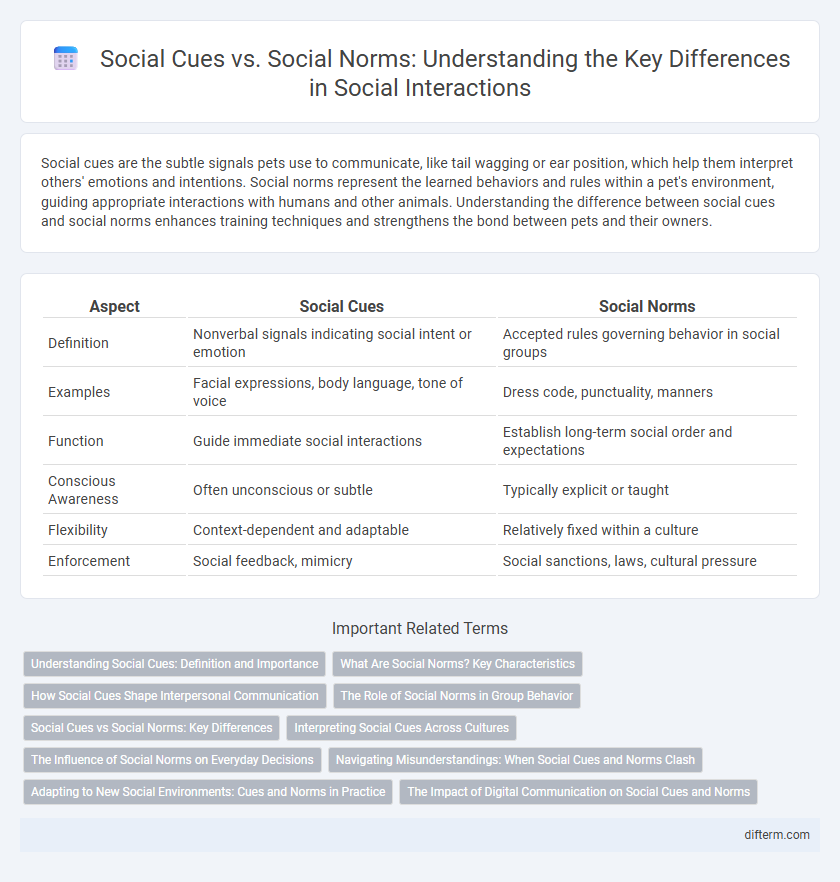Social cues are the subtle signals pets use to communicate, like tail wagging or ear position, which help them interpret others' emotions and intentions. Social norms represent the learned behaviors and rules within a pet's environment, guiding appropriate interactions with humans and other animals. Understanding the difference between social cues and social norms enhances training techniques and strengthens the bond between pets and their owners.
Table of Comparison
| Aspect | Social Cues | Social Norms |
|---|---|---|
| Definition | Nonverbal signals indicating social intent or emotion | Accepted rules governing behavior in social groups |
| Examples | Facial expressions, body language, tone of voice | Dress code, punctuality, manners |
| Function | Guide immediate social interactions | Establish long-term social order and expectations |
| Conscious Awareness | Often unconscious or subtle | Typically explicit or taught |
| Flexibility | Context-dependent and adaptable | Relatively fixed within a culture |
| Enforcement | Social feedback, mimicry | Social sanctions, laws, cultural pressure |
Understanding Social Cues: Definition and Importance
Social cues are verbal and nonverbal signals, such as facial expressions, gestures, and tone of voice, that guide interpersonal interactions by indicating how to respond appropriately in social settings. Understanding social cues is crucial for effective communication and relationship building because they provide real-time feedback about others' emotions, intentions, and expectations. Mastery of social cues enhances empathy, reduces misunderstandings, and helps individuals navigate complex social environments beyond the basic framework of social norms.
What Are Social Norms? Key Characteristics
Social norms are unwritten rules that govern behavior within a group, shaping expectations and promoting social order. Key characteristics include their collective nature, enforcement through social sanctions, and their role in guiding appropriate and acceptable actions in various contexts. These norms adapt over time and vary across cultures, influencing how individuals interpret and respond to social cues.
How Social Cues Shape Interpersonal Communication
Social cues, including facial expressions, tone of voice, and body language, play a critical role in shaping interpersonal communication by providing real-time feedback and contextual information that guide responses and behaviors. These nonverbal signals enable individuals to interpret emotions, intentions, and social subtleties, fostering empathy and mutual understanding within interactions. Unlike social norms, which dictate expected behaviors based on cultural or societal rules, social cues offer dynamic and immediate insight that adapts communication to the unique circumstances of each social encounter.
The Role of Social Norms in Group Behavior
Social norms establish shared expectations within a group, guiding behavior through unwritten rules that maintain cohesion and predictability. These norms influence how individuals interpret social cues, shaping responses to group dynamics and reinforcing conformity. Understanding the interaction between social norms and cues is critical for analyzing collective decision-making and conflict resolution in social settings.
Social Cues vs Social Norms: Key Differences
Social cues are subtle signals like facial expressions, tone of voice, and body language that help individuals interpret others' emotions and intentions in real-time interactions. Social norms represent the established rules and expectations within a group or society regarding acceptable behavior, often learned through cultural and societal influences. Understanding the key differences between social cues and social norms is crucial for effective communication and social adaptability in diverse environments.
Interpreting Social Cues Across Cultures
Interpreting social cues varies significantly across cultures, as nonverbal signals like eye contact, gestures, and personal space hold different meanings worldwide. Social norms dictate acceptable behaviors in specific contexts, but social cues provide immediate, subtle information guiding interpersonal interactions beyond explicit rules. Understanding these cultural variations enhances effective communication and reduces misunderstandings in multicultural environments.
The Influence of Social Norms on Everyday Decisions
Social norms serve as unwritten rules that shape everyday decisions by guiding acceptable behavior within communities and societies. These norms influence choices ranging from attire and language to professional conduct, often operating subconsciously to align individual actions with group expectations. Understanding social cues enables individuals to interpret and adapt to these norms effectively, ensuring smoother social interactions and cohesion.
Navigating Misunderstandings: When Social Cues and Norms Clash
Navigating misunderstandings often occurs when social cues conflict with established social norms, creating confusion in interpersonal interactions. Social cues, such as body language and tone, provide immediate, context-dependent signals, whereas social norms represent broader, culturally ingrained expectations guiding behavior. Effective communication requires recognizing when cues deviate from norms and interpreting these discrepancies to prevent misinterpretations and social friction.
Adapting to New Social Environments: Cues and Norms in Practice
Adapting to new social environments requires recognizing and interpreting social cues such as body language and tone of voice, which provide immediate feedback for appropriate behavior. Social norms, including accepted dress codes and communication styles, offer a framework for long-term integration and expected conduct within a community. Mastery of both social cues and norms enhances social competence, facilitating smoother interactions and stronger relationships in diverse social settings.
The Impact of Digital Communication on Social Cues and Norms
Digital communication profoundly alters social cues, often diminishing nonverbal signals like tone, facial expressions, and body language essential for effective interpersonal interaction. This shift challenges traditional social norms by creating ambiguous contexts where misinterpretation increases, impacting relationships and etiquette within virtual communities. Platforms like social media and messaging apps reshape social norms by accelerating information exchange and expanding the boundaries of acceptable online behavior.
social cues vs social norms Infographic

 difterm.com
difterm.com